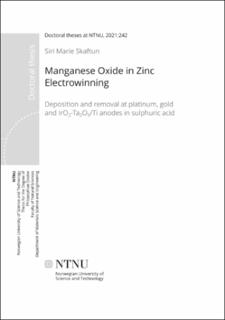Manganese Oxide in Zinc Electrowinning: Deposition and removal at platinum, gold and IrO2-Ta2O5/Ti anodes in sulphuric acid
Abstract
An environmentally friendly and energy efficient replacement for lead anodes in zinc electrowinning is highly desired. Oxygen evolution reaction (OER) is the desired anode reaction in acidic sulphate electrolytes. However, manganese oxide forms in large quantities at the anode during zinc electrowinning due to the presence of dissolved manganese in the electrolyte. Manganese oxide formation causes increased cell resistance, increases the risk of short circuits and prevents implementation of catalytic anode materials. To succeed, a method is required for removing deposited manganese oxide from these anodes without destroying the catalytic coating.
A deeper understanding of the mechanism of manganese oxide formation and reduction can lead to better control over the deposit formed in the zinc electrowinning process and make it possible to suggest an electrochemical procedure for removing it.
In this thesis, the mechanism of manganese oxide formation and reduction at platinum, gold, titanium and IrO2-Ta2O5/Ti electrodes is studied using conventional electrochemical methods, such as cyclic voltammetry, linear sweep voltammetry and chronoamperometry, as well as electrochemical quartz crystal microbalance (EQCM) and in-situ Raman spectroscopy. The morphology of deposited manganese oxide is also examined. The mechanism for manganese oxide deposition and reduction is found to depend on many factors; most importantly pH, electrode potential and thickness of the deposit, i.e. with deposition time.
An electrochemical procedure for removal of deposited manganese oxide is developed, and is further validated in synthetic electrolyte. The sequence involves applying several electrode potentials, including forming a prelayer of manganese oxide at a low electrode potential (1.45 V), which is shown to reduce easier. Only a short reduction step, i.e. seconds, is necessary as this reduction diminishes the adhesion of remaining manganese oxide, which can then easily be removed mechanically.
This thesis reveals that it is possible to remove deposited manganese oxide by a procedure involving a sequence of electrode potentials. Implementing such a procedure can make it possible to replace the lead anodes used in zinc electrowinning today with more energy efficient and environmentally friendly anodes.
